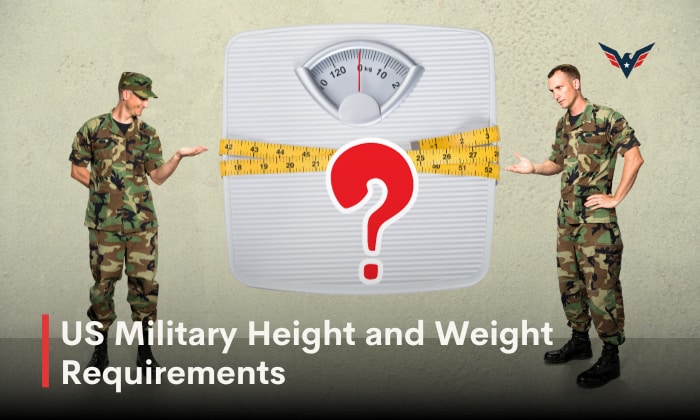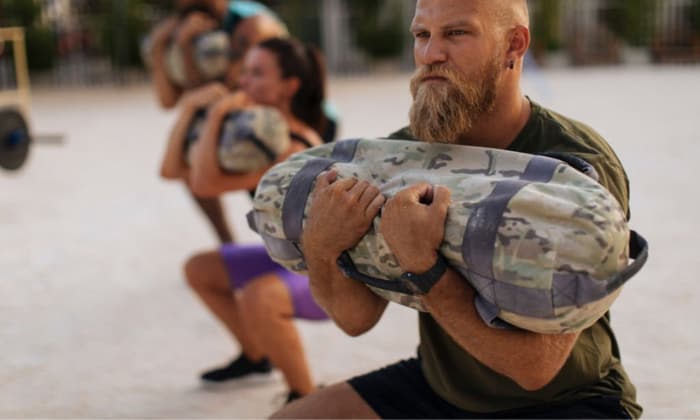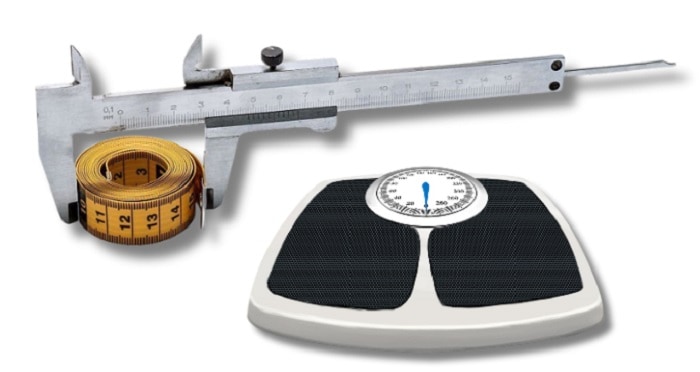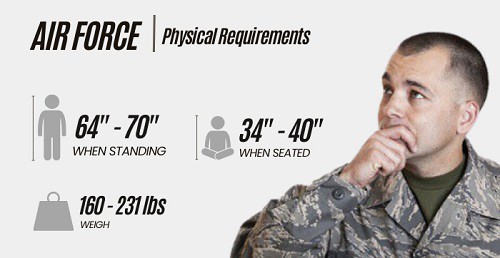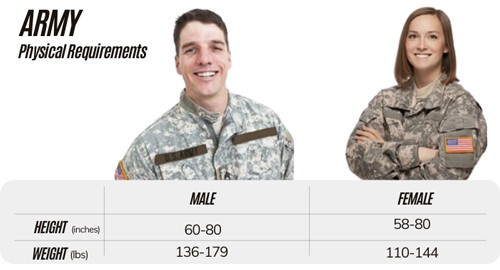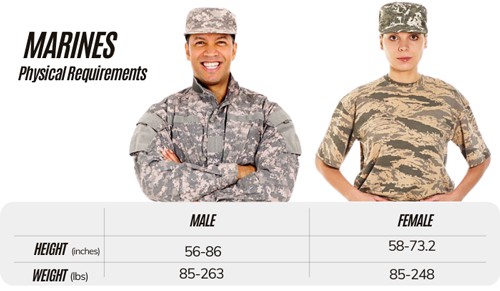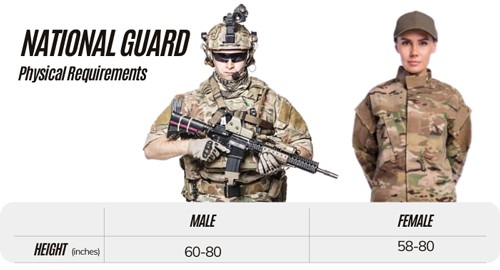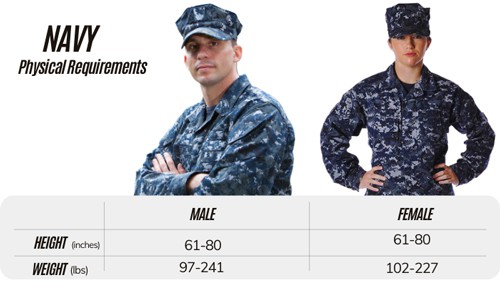Setting stringent physical standards to ensure the readiness and effectiveness of the armed services’ members is essential to keeping an army that can hold its own in a crisis.
The US military height and weight requirements are among the important factors considered while vetting potential recruits for the service.
This article explores the finer points of the US military’s weight and height specifications. We will explain the relevance of these rules and how they affect potential recruits.
We strive to provide a comprehensive overview to prepare aspirants for their journey toward military duty. We will cover everything from the reasoning behind these criteria to examining the difficulties they create.
Table of Contents
US Military Height and Weight Standards
To join the prestigious United States military force, one must first demonstrate that they are physically ready for the demands of military service.
The Army uses two main measurements to determine a soldier’s fitness level, ensuring that they have the best possible physical capabilities.
- The Army Physical Fitness Test is used to evaluate the candidate’s level of physical fitness.
- Meanwhile, the Army Height and Weight Standards play a crucial part in assessing if an individual fulfills the required weight and height criteria.
While scoring well on the Army PFT is certainly impressive, it is still necessary to adhere to the service’s height and weight requirements to qualify. Meeting the
The Army’s weight and height criteria is a must if you want to enlist, regardless of how well you do on the PT exam.
Here’s a height and weight chart to give you an idea regarding these standards:
| Male | ||
| Height Range | Minimum Weight (lbs) | Maximum Weight (lbs) |
| 58 – 60 in | 91 | 132 |
| 61 – 63 in | 97 | 141 |
| 64 – 66 in | 104 | 150 |
| 67 – 69 in | 110 | 160 |
| 70 – 72 in | 116 | 170 |
| 73 – 75 in | 122 | 181 |
| 76 – 78 in | 128 | 191 |
| 79 – 81 in | 135 | 201 |
| 82 – 84 in | 141 | 211 |
| Female | ||
| Height Range | Minimum Weight (lbs) | Maximum Weight (lbs) |
| 58 – 60 in | 91 | 123 |
| 61 – 63 in | 97 | 129 |
| 64 – 66 in | 104 | 135 |
| 67 – 69 in | 110 | 141 |
| 70 – 72 in | 116 | 147 |
| 73 – 75 in | 122 | 153 |
| 76 – 78 in | 128 | 159 |
| 79 – 81 in | 135 | 165 |
| 82 – 84 in | 141 | 171 |
Branch-specific Height and Weight Requirements
There are different physical requirements, maximum weights, and minimum heights for enlistment in the Navy, Army, National Guard, Marines, and Air Force.
There are also variations in these standards by age and gender, among other considerations, which a recruit must meet to join a certain branch.
1. Air Force
Specific measures are used by the U.S. Air Force to evaluate the fitness levels of incoming Airmen. Unlike in the Army, BMI standards are strictly followed by the Air Force.
The Body Mass Index (BMI) is a crucial indicator of body composition in the USAF.
The BMI range used by the Air Force to determine fitness is 17.5 to 27.5. If a recruit’s BMI is outside the acceptable limit, they are subjected to a body fat tape test utilizing the waist-to-height ratio, which calculates their body fat percentage.
Additionally, qualifications are needed for several Air Force posts, such as pilot and aircrew positions.
- Candidates must be between the height requirements of 34 and 40 inches when seated and between the height requirements of 64 and 77 inches when standing.
- Prospective pilots must also weigh between 160 and 231 pounds.
2. Army
Those who want to join the Army must adhere to the following weight and height requirements:
Standards for Female Soldiers’ Height and Weight
- Height: Female soldiers must be at least 58 inches (4 feet 10 inches) and no taller than 80 inches (6 feet 8 inches) to serve.
- Weight: Depending on the soldier’s height and age, there are several allowable weight ranges. For instance, a female soldier who is 5 feet 4 inches tall and between the ages of 21 and 27 should weigh between 110 and 144 pounds.
Male Soldier Height and Weight Requirements:
- Height: Male troops must be at least 60 inches (5 feet) and at most 80 inches (6 feet 8 inches) in height.
- Weight: Just like with women, the soldier’s height and age determine the allowed weight range. For instance, a male soldier who is 5 feet 9 inches tall and between the ages of 21 and 27 should weigh between 136 and 179 pounds.
3. Marines
USMC Height and weight requirements for males:
- Male Marines must weigh between 85 and 122 lbs. and be at least 4’8″ (56 inches) tall.
- For Marines of this height, the maximum height permitted is 6’10” (86 inches), with a matching weight range of 182 to 263 pounds.
USMC Height and weight requirements for females:
- Female Marines must also weigh between 85 and 115 lbs. and be at least 4’8″ (56 inches) tall.
- The maximum height for female Marines is 6’10”, and they must stay within this height range by weighing between 182 and 248 lbs.
4. National Guard
Required Height
- Men: For men, the required height is between 5 feet and 6 feet 8 inches and 60 to 80 inches.
- Women: Their heights must range from 58 to 80 inches (4 feet 10 to 6 feet 8 inches).
Required Weight
- In the Army National Guard, determining a person’s level of fitness and general health depends heavily on their body fat composition. The allowed military weight limit is determined by their height and gender. To check if you are eligible, you may use this army height and weight calculator.
Navy Height and Weight Standards for Females:
- The Minimum Height is 5 feet 1 inch while the
Maximum Height: 6 feet 8 inches.
- The Minimum Weight Is 102 lbs while the
Maximum Weight is 227 lbs
Navy Height and Weight Standards for Males:
- The Minimum Height is 5 feet 1 inch while the Maximum Height is 6 feet 8 inches
- The Minimum Weight is 97 lbs while the Maximum Weight is 241 lbs
Frequently Asked Questions
Are there any exceptions concerning height and weight requirements in the US military?
Yes, there are indeed exceptions. The U.S. Army has issued an order waiving the body fat evaluation for any Soldiers wh.o have earned a score of 540 or higher on the Army Combat Fitness Test, regardless of their height or weight. Each soldier must achieve an overall score of 80 or higher.
Michael Grinston, the Sergeant Major of the Army, made the announcement. “When our people are ready, the Army is ready,” he added.
How tall is too tall for the military?
The height requirement for men serving in the armed forces should ideally fall anywhere between 60 and 80 inches (or 152-203 cm).
Anyone who does not meet this condition, or who does so inadequately, has a good chance of being rejected. The height limits are arbitrary, but everyone who falls within that range has a chance of being approved as long as their weight is within the acceptable range for that limit.
How to calculate your body fat percentage?
The Standards of Medical Fitness state that body fat is measured based on a person’s physical dimensions, which include height, neck, waist, and hip sizes for women and males, respectively.
The individual should be standing straight while being measured, with their arms at their sides.
Conclusion
Compliance with US military height and weight requirements is essential for both initial recruiting and continued service in the armed forces. These rules were designed with great care to ensure that service members are physically fit to carry out their duties and defend the nation.
The Army has strict weight and height requirements for a reason. Maintaining a healthy weight increases physical fitness, endurance, and agility, all of which are essential for military service.
Equipment use, space constraints, and efficiency in fighting, meanwhile, are also taken into account while determining optimal height. Maintaining these criteria ensures soldiers’ health and readiness.

I am Everett Bledsoe, taking on the responsibility of content producer for The Soldiers Project. My purpose in this project is to give honest reviews on the gear utilized and tested over time. Of course, you cannot go wrong when checking out our package of information and guide, too, as they come from reliable sources and years of experience.

